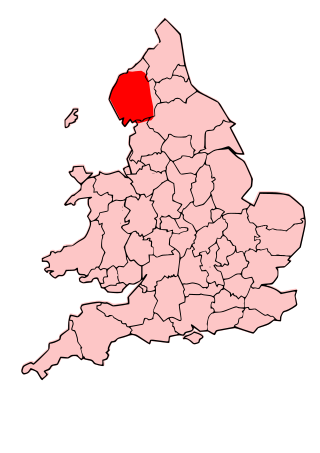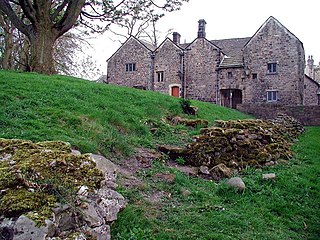
The Carvetii were a Brittonic Celtic tribe living in what is now Cumbria, in North-West England during the Iron Age, and were subsequently identified as a civitas (canton) of Roman Britain.

Ilkley Roman Fort is a Roman fort on the south bank of the River Wharfe, at the centre of the modern town of Ilkley, a Victorian spa town in West Yorkshire, England.

The Epidii were a people of ancient Britain, known from a mention of them by the geographer Ptolemy c. 150. Epidion has been identified as the island of Islay in modern Argyll. Ptolemy does not list a town for the Epidii, but the Ravenna Cosmography mentions Rauatonium, which is assumed to be Southend.
The Deciates (Δεκιήταις) were a Ligurian tribe dwelling near on the Mediterranean coast, around present-day Antibes, during the Iron Age and the Roman era.
The Novantae were a people of the late 2nd century who lived in what is now Galloway and Carrick, in southwesternmost Scotland. They are mentioned briefly in Ptolemy's Geography, and there is no other historical record of them. Excavations at Rispain Camp, near Whithorn, show that it was a large fortified farmstead occupied between 100 BC and 200 AD, indicating that the people living in the area at that time were engaged in agriculture.

The Taexali were a people of ancient Scotland, known only from a single mention of them by the geographer Ptolemy c. 150. From his general description and the approximate location of their town or principal place that he called 'Devana', their territory was along the northeastern coast of Scotland and is known to have included Buchan Ness, as Ptolemy refers to the promontory as 'Taexalon Promontory'.

The Cavarī or Cavarēs were a Gallic tribe dwelling in the western part of modern Vaucluse, around the present-day cities of Avignon, Orange and Cavaillon, during the Roman period. They were at the head of a confederation of tribes that included the Tricastini, Segovellauni and Memini, and whose territory stretched further north along the Rhône Valley up to the Isère river.

The Nemetes E.g. Frederick Kohlrausch "History of Germany. From the Earliest Period to the Present Time". D.Appleton and Company, New York, 1880. p. 40.</ref> were a tribe settled along the Upper Rhine by Ariovistus in the 1st century BC.
The Cornovii is a hypothetical name for a tribe presumed to have been part of the Dumnonii, a Celtic tribe inhabiting the south-west peninsula of Great Britain, during some part of the Iron Age, Roman and post-Roman periods. The Cornovii are supposed to have lived at the western end of the peninsula, in the area now known as Cornwall, and if the tribal name were correct it would be the ultimate source of the name of that present-day county.

The Parisi were a British Celtic tribe located somewhere within the present-day East Riding of Yorkshire, in England, known from a single brief reference by Ptolemy in his Geographica of about AD 150. Many writers have connected them with the archaeological Arras culture and some with the more widely known Parisii of Gaul.

The Diablintes or Aulerci Diablites were a Gallic tribe dwelling in the north of the modern Mayenne department during the Iron Age and the Roman period. They were part of the Aulerci.

The Decantae were a people of ancient Britain, known only from a single mention of them by the geographer Ptolemy c. 150. From his general description and the approximate locations of their neighbors, their territory was along the western coast of the Moray Firth, in the area of the Cromarty Firth. Ptolemy does not provide them with a town or principal place.

The Smertae were a people of ancient Britain, known only from a single mention of them by the geographer Ptolemy c. 150. From his general description and the approximate locations of their neighbors, their territory was in the modern area of central Sutherland. Ptolemy does not provide them with a town or principal place.
Common Brittonic, also known as British, Common Brythonic, or Proto-Brittonic, was a Celtic language spoken in Britain and Brittany.
The Gabrantovices were a conjectural group of Ancient Britons inhabiting the coast of what is now Yorkshire in Northern England. They may have been a sub-tribe or sept of the Brigantes or of the Parisi.
The Avatici were a Gallic tribe dwelling near the Étang de Berre, between the mouth of the Rhône river and Massilia, during the Roman period.
The Avantici were a small Gallic tribe dwelling around present-day Gap, in the western part of the modern Hautes-Alpes department, during the Roman period.
The Vediantii were a Celto-Ligurian tribe dwelling on the Mediterranean coast, near present-day Nice, during the Iron Age and the Roman period.
The Sentii were a small Gallic tribe dwelling around present-day Senez, in southeastern France, during the Roman era.
The Suetrii or Suetri were a Gallic tribe dwelling around present-day Castellane (Alpes-de-Haute-Provence) during the Iron Age and the Roman period.







